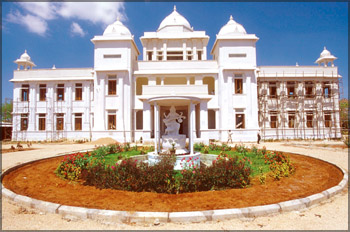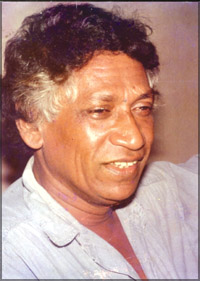Dharmasena Pathiraja as peacemaker
A. Kandappah
It is only a sense of politeness that keeps members of the two major
communities accepting, even with a degree of genuine regret, that they
are now more polarised than ever before.
More sadly, the chasm between the influential elite in the two
communities have become wider with the passage of time and dreadful
events.
In a multi-ethnic society that has enjoyed generations of racial
tranquillity such an unwelcome development is always a matter of deep
concern.
Though both communities continue to interact with each other
courteously, there is mutual suspicion and
|

GIFT OF PEACE: Jaffna Public Library being rebuilt, with partly
burned right wing. At the front is a statue of Godess Saraswati the
Hindu God of Learning. The restoration work cost approximately US $
1 million and the library was opened to the public in 2003. Picture
courtesy: Wikipedia.com
|
prejudice below the surface.
In this poisoned atmosphere raising hope are players and activists in
both communities continuing a struggle against great odds to recapture
society to her earlier accommodative past.
Dharmasena Pathiraja‚Äôs cinematic effort ‚ÄúA Road to Nowhere‚ÄĚ - that
was shown to a packed audience of academics and professionals at the
small ICES Auditorium on May 10 - falls within this domain.
Pathiraja goes back to 1905 when the 200 plus miles dividing the
Tamil-dominated Northern Peninsula from the Sinhala-dominated South, and
- particularly Colombo; when time and distance were made closer by the
then British colonialists.
Admittedly, to serve their own economic and political interest as
well as a link to the massive Indian Sub-Continent “the Jewel of the
Crown‚ÄĚ also under their sphere of influence. The railroad went out to
enrich both Sinhala and Tamil societies - perched as they were at each
extreme.
The Tamil and Sinhala communities who remained virtually separate
during the pre-British colonial period and before were brought closer by
this rail link.
Larger and more frequent movement of people to and fro, their
economic and other social interests were no longer parochially district-centred
but assumed a national-centric character.
Pathiraja, like many contemporary historians, chooses to suggest
post-1956 majoritarian political events grievously ruptured this welcome
link between the two ancient communities.
Pathiraja poignantly points out the rail and the A9 road link from
Kandy to Jaffna brought in the two communities closer.
In a supremely convincing endeavour - apparently supported by
high-profile peaceniks at both ends - Tissa Abayasekera, Sumathi
Sivamohan (sister of the late Rajini Tiranagama) and many others.
Interestingly, the LTTE is not left.
In the acknowledgements at the end of the movie the name of LTTE’s
Daya Master was given prominent place.
In trying to present the main actors on both sides of this tragic
human drama Pathiraja does well to bring in the Tamil-speaking Sinhala
Bakery mudalali settled in Jaffna who happily refers to himself “as part
of Jaffna society‚ÄĚ - accepted by Jaffna Tamils as such.
|

LIFE GOES ON:Smiling girls of Jaffna
|
And there is a Tamil Clerk boarded in a Sinhala home in Colombo who
tearfully bids goodbye to his landlord couple “with the introduction of
Sinhala only, I am on the verge of losing my job because I do not read
and write Sinhala.‚ÄĚ
On the other side of the spectrum, the Sinhala clerk who says “I
enjoyed being part of the Jaffna family but the post-1956 events make my
Tamil friends now look at me strangely.‚ÄĚ
Alas! While it takes generations to build bridges of friendship
between two communities, political chicanery can destroy such wonderful
relationships in a matter of months. The typical Sinhala middle class
parents in Anuradhapura were bidding farewell to their teenage son in
the railway station.
The boy was going to a high-school in Jaffna - a famed Christian
educational institution.
The father says “Some of the best Sinhala families in the
Anuradhapura District send their children to Jaffna. All of them
eventually become successful in life.‚ÄĚ The parents were hoping for such
an eventuality to their son.
This takes one’s memory back and brings to mind such names as Senior
SLFP Minister Maithripala Sirisena, Speaker K.B. Ratnayake, UNP Minister
E.L.B. Hurulle et al - all of whom students of distinguished Jaffna
Educational Institutions. All three reportedly were fluent Tamil
speakers.
The scene then shifts to a young lady expatriate Tamil (from where
else but Toronto?) who drives via the A9 from Kandy to Jaffna and
suffers two ‚ÄėCustoms and Immigration‚Äô points in one country. She is here
to persuade her father to leave this war-ravaged land and come to the
safer climes in Canada. The father has many friends in the Sinhala
community.
He sees the Sinhalese, landmarks in the South and the North as
symbols of his own being and refuses to be cut off from all of this
heritage. He pleads with his daughter “Magal, these are our symbols and
without them, what are we?‚ÄĚ
Then the other man from Jaffna who had returned to the town after
many years overseas. He cannot recognise his beloved town and when he
enquires about ‚ÄúSubhas Hotel‚ÄĚ he engages a laugh. The Jaffna he knew and
its historic landmarks - the railway station, the Kachcheri and the GA’s
Bungalow all lay in ruins.
The sudden demand of the LTTE ordering the eviction of a half a
million people from their homes in a matter of hours is captured
effectively by Pathiraja.
The pain of this mass of humanity moving miles on feet carrying their
meagre belongings, the deep anguish in
|

PEACEMAKER: Dharmasena Pathiraja
|
their faces speaks adequately of man’s inhumanity to man and
the depths to which man can descend in the pursuit of political power.
The 28-year-old young Muslim girl was visiting after 14 years and is
anxious to see what was once her home.
Her once beautiful and comfortable home is unrecognisable, in ruins
and rubble having received regular shell-attacks. In the empty space she
encounters another Tamil girl of similar age and enquires of Malarvalli,
who was a neighbour.
The girl answers “I don’t know. We are strangers to this area
ourselves. I am from Vallikamam. Our homes there were destroyed by
air-attacks. To escape from the shelling and the fighting we moved
aimlessly and are now here. We do not know when we will go and where we
will go?‚ÄĚ
The old Peradeniya Professor is pleased to meet his former young
Sinhala student and despite the gloom and deprivation around him, he has
not lost his sense of courtesy. He enquires about the well-being of
other Sinhala friends and students. The Professor says “I came to Jaffna
to help the students here and to be with my family.
But everything remains destroyed. Now I do my work with the little we
have. Whatever is left of the Kerosene that is available.
The frightened, teenage girl in the bunker with a candle in her hand
trying to protect her from regular aerial attacks reminds one, in
today’s context, the scene can shift to Colombo anytime, God forbid! to
our dismay. Pathiraja proves that everyone in this sordid game of
political-military adventure has lost.
There are no victors on either side. The net result is, it has
destroyed what was once two peaceful, friendly, educated ancient
societies - who sometimes even inter-married breaching the racial,
religious and caste barrier factors.
The characters and events incorporated in the film in many ways have
some relevance to many of us and thus makes the exercise that much more
relevant.
It is the good fortune of our society we have talented men and women
like Pathiraja struggling against odds to rebuild our fractured society.
To the outside world, who might think Sri Lanka’s racial division is
irrevocably beyond reconcilitation, artistes like Pathiraja bring in a
fresh breath of hope.
The enterprise can be fraught with danger to them. They can be
labelled ‚Äútraitors‚Äô ‚Äúunpatriotic‚ÄĚ or even be classified as ‚ÄúSinhala
Kotiyas‚ÄĚ - a sobriquet now in vogue that can destroy any Sinhala
perceived enemy. And, the sad saga goes on. The vanity of both warring
sides to win at any cost gathers momentum - the huge human cost in its
wake is not given hardly any worthwhile thought. That the country is at
the brink of disintegration and total anarchy is nobody’s concern.
It is poetic justice that such a powerful cinematic endeavour at
reconciliation should be screened in an institution whose name is
synonymous with one of Sri Lanka’s most beloved of peace builders who
made the supreme sacrifice in its quest - the late Neelan Thiruchelvam.
His beautiful thoughts to make ‚ÄúLife - a celebration‚ÄĚ to all of us
Sinhalese, Tamils, Muslims is carried forward many miles by Dharmasena
Pathiraja by this singularly triumphant work of art. |

